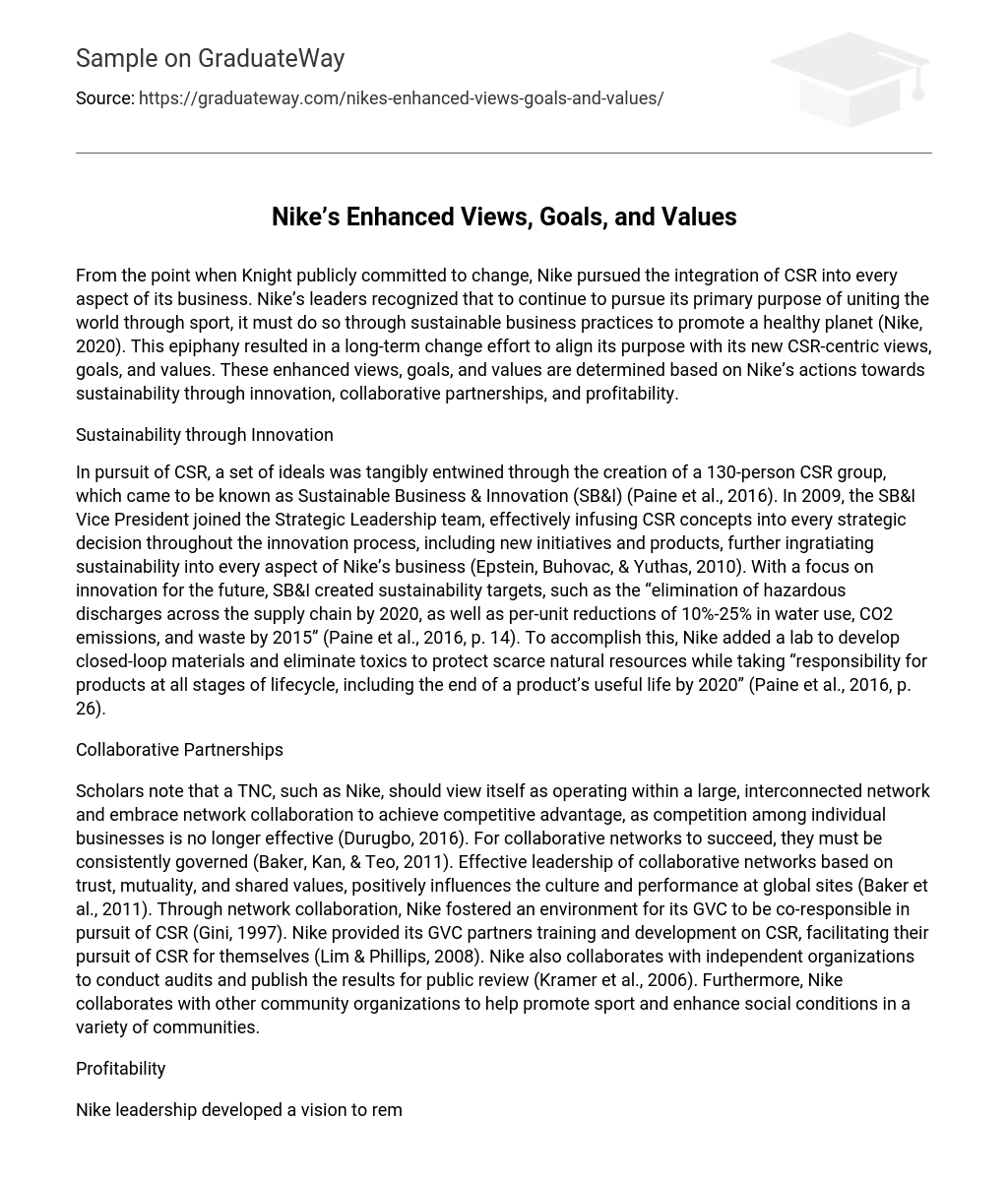From the point when Knight publicly committed to change, Nike pursued the integration of CSR into every aspect of its business. Nike’s leaders recognized that to continue to pursue its primary purpose of uniting the world through sport, it must do so through sustainable business practices to promote a healthy planet (Nike, 2020). This epiphany resulted in a long-term change effort to align its purpose with its new CSR-centric views, goals, and values. These enhanced views, goals, and values are determined based on Nike’s actions towards sustainability through innovation, collaborative partnerships, and profitability.
Sustainability through Innovation
In pursuit of CSR, a set of ideals was tangibly entwined through the creation of a 130-person CSR group, which came to be known as Sustainable Business & Innovation (SB&I) (Paine et al., 2016). In 2009, the SB&I Vice President joined the Strategic Leadership team, effectively infusing CSR concepts into every strategic decision throughout the innovation process, including new initiatives and products, further ingratiating sustainability into every aspect of Nike’s business (Epstein, Buhovac, & Yuthas, 2010). With a focus on innovation for the future, SB&I created sustainability targets, such as the “elimination of hazardous discharges across the supply chain by 2020, as well as per-unit reductions of 10%-25% in water use, CO2 emissions, and waste by 2015” (Paine et al., 2016, p. 14). To accomplish this, Nike added a lab to develop closed-loop materials and eliminate toxics to protect scarce natural resources while taking “responsibility for products at all stages of lifecycle, including the end of a product’s useful life by 2020” (Paine et al., 2016, p. 26).
Collaborative Partnerships
Scholars note that a TNC, such as Nike, should view itself as operating within a large, interconnected network and embrace network collaboration to achieve competitive advantage, as competition among individual businesses is no longer effective (Durugbo, 2016). For collaborative networks to succeed, they must be consistently governed (Baker, Kan, & Teo, 2011). Effective leadership of collaborative networks based on trust, mutuality, and shared values, positively influences the culture and performance at global sites (Baker et al., 2011). Through network collaboration, Nike fostered an environment for its GVC to be co-responsible in pursuit of CSR (Gini, 1997). Nike provided its GVC partners training and development on CSR, facilitating their pursuit of CSR for themselves (Lim & Phillips, 2008). Nike also collaborates with independent organizations to conduct audits and publish the results for public review (Kramer et al., 2006). Furthermore, Nike collaborates with other community organizations to help promote sport and enhance social conditions in a variety of communities.
Profitability
Nike leadership developed a vision to remove scarce resources from its growth strategy (Paine et al., 2016). Nike’s CSR targets underwent a series of checks and balances to offer stakeholders and shareholders reassurance that the financial investments were reasonable and sensible (Paine et al., 2016). Nike implemented initiatives, such as Reuse-A-Shoe, a product recycling business, to create profitability through CSR (Paine et al., 2016). Nike’s investments in long-term growth and innovation were CSR-centric, and its evolution to becoming a change agent and sustainability leader has kept it among the most successful brands.
Evaluation of Societal Trends, Global Business, and the Big Picture
Not unlike numerous other organizations, Nike underwent several transformations. In its early days, its leaders reacted defensively. Yet as it evolved and matured in its authenticity, Nike has become proactive and generates change based on forecasting needs for the future (Paine et al., 2016). Societal and global trends such as brand image, globalization, and technology influenced Nike’s transformational change effort towards holistic CSR. These more salient mega-trends continue to influence Nike’s quest for continuous CSR improvement.
Societal & Global Trends
Brand Image
According to Popoli (2015), among the “most important intangible assets for firm’s competitiveness is brand image, reflecting all that which leads to the firm” (p.23). In its early days, the Nike brand was synonymous with performance through its association with elite athletes (Paine et al., 2016). Faced with growing competition and consumer preference, Nike shifted its brand to include ‘the rest of us’ and added clothing, a logo, and a targeted marketing campaign (Flamholtz & Randle, 1998). Nike went from selling athletic apparel to an intangible ideal of sports and fitness, transforming its brand image (Flamholtz & Randle, 1998). However, as consumers view organizations not just by the products they sell but also by what they stand for, their values, and their political and social affiliations (Popoli, 2015), brand image must transcend product differentiation and fancy logos. As society evolves, consumers become more conscientious about environmental and social issues; therefore, CSR and brand image are closely interrelated (Popoli, 2015).
Brand Image Evolved. Brand image further drives Nike’s CSR policy to include authentic leadership of others in pursuit of CSR for themselves. Consumers have increased expectations of large organizations that have access to human and financial resources to influence others and affect positive change (Ali, 2014). From a systems perspective, society evaluates the behavior of a TNC along with the behaviors of others within its network, and an authentic demonstration of CSR throughout the entire network fosters a positive brand image (Popoli, 2015). For example, Greenpeace implicated Nike in a high-profile campaign to expose and challenge well-known apparel companies to prevent suppliers from polluting the water supply, even though the suppliers were not part of its GVC (Paine et al., 2016). Nike embraced the challenge and pursued a solution to address the water pollution issue, demonstrating its pursuit of CSR in a systems perspective to uphold its brand image.
Today, Nike is a CSR leader, and its brand image has evolved to encompass its pursuit of sustainability through innovation (Paine et al., 2016). Due to the strength of its brand image, governments, regulatory bodies, and others in the industry look to Nike as a consultant and an example of a good corporate citizen (Epstein et al., 2010).





